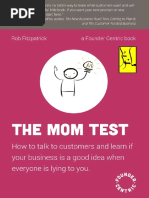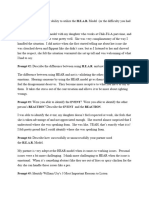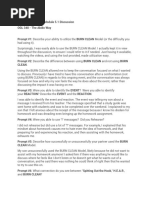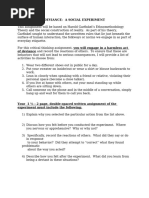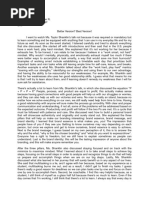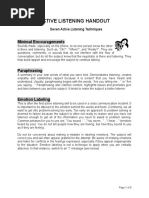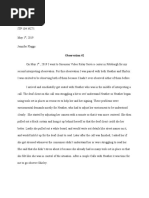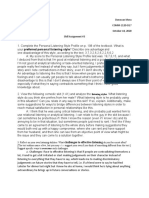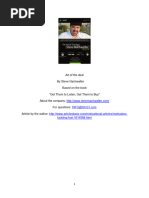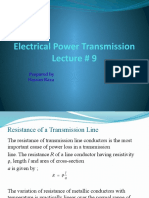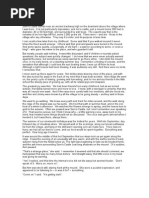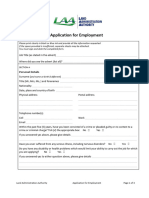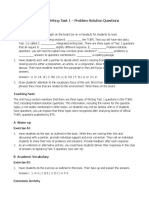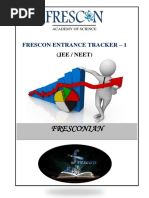0 ratings0% found this document useful (0 votes)
22 viewsHear Model
Hear Model
Uploaded by
api-3912273841) The customer called to complain that his daughter's birthday drink order was made incorrectly. The barista used the HEAR model to understand the problem, apologize, and offer a replacement drink and $5 gift card.
2) When using HEAR, one is more likely to uncover the real underlying issues and resolve them, rather than just addressing surface complaints.
3) In this example, the event was an incorrect drink, and the customer's reaction was frustration because it made his daughter's birthday less special.
Copyright:
© All Rights Reserved
Available Formats
Download as PDF, TXT or read online from Scribd
Hear Model
Hear Model
Uploaded by
api-3912273840 ratings0% found this document useful (0 votes)
22 views2 pages1) The customer called to complain that his daughter's birthday drink order was made incorrectly. The barista used the HEAR model to understand the problem, apologize, and offer a replacement drink and $5 gift card.
2) When using HEAR, one is more likely to uncover the real underlying issues and resolve them, rather than just addressing surface complaints.
3) In this example, the event was an incorrect drink, and the customer's reaction was frustration because it made his daughter's birthday less special.
Original Title
hear model
Copyright
© © All Rights Reserved
Available Formats
PDF, TXT or read online from Scribd
Share this document
Did you find this document useful?
Is this content inappropriate?
1) The customer called to complain that his daughter's birthday drink order was made incorrectly. The barista used the HEAR model to understand the problem, apologize, and offer a replacement drink and $5 gift card.
2) When using HEAR, one is more likely to uncover the real underlying issues and resolve them, rather than just addressing surface complaints.
3) In this example, the event was an incorrect drink, and the customer's reaction was frustration because it made his daughter's birthday less special.
Copyright:
© All Rights Reserved
Available Formats
Download as PDF, TXT or read online from Scribd
Download as pdf or txt
0 ratings0% found this document useful (0 votes)
22 views2 pagesHear Model
Hear Model
Uploaded by
api-3912273841) The customer called to complain that his daughter's birthday drink order was made incorrectly. The barista used the HEAR model to understand the problem, apologize, and offer a replacement drink and $5 gift card.
2) When using HEAR, one is more likely to uncover the real underlying issues and resolve them, rather than just addressing surface complaints.
3) In this example, the event was an incorrect drink, and the customer's reaction was frustration because it made his daughter's birthday less special.
Copyright:
© All Rights Reserved
Available Formats
Download as PDF, TXT or read online from Scribd
Download as pdf or txt
You are on page 1of 2
Prompt #1:
Describe your ability to utilize the H.E.A.R. Model (or the difficulty you had
using it).
For this activity I used an experience that I had at work today. My partner wasn’t
aware that they were my partner but I wanted to test it out in a real situation. I work at
Starbucks so there are often conflicts between customers and baristas. Today I had a
customer call in to let me know that he was unsatisfied with his drink. I started by
asking him what the problem was, and hearing his concerns. I found out that he asked
for something specific in his drink and didn’t get it. I apologized to him and told him
that he could come back to the store and tell the barista that I offered him a free drink. I
wrote a note and put it in the drive thru so that the specifications were clear. He
thanked me and said he would be back in later in the day. I asked him at the end if
there was anything else that we could do for him. I found out the drink was for his
daughter and that it was her birthday, and that the drink was wrong so it was less
special. I used this as an opportunity to decorate the drink, and I told him that we
would add in a free $5 gift card to make her birthday a little bit better. This instance
was easy to use the HEAR model because both parties were willing to negotiate and
listen.
Prompt #2: Describe the difference between using H.E.A.R. and not using H.E.A.R.
When you use the HEAR model, you are more likely to solve all of the underlying
issues. When we talked about spitting out the hook, we were aware that sometimes
people’s responses are based on an event that has nothing to do with what is
happening in that moment. When you clarify and listen using the HEAR model, you are
more likely to uncover the real problems, and fix them.
Prompt #3: Were you able to identify the EVENT? Were you able to identify the other
person's REACTION? Describe the EVENT and the REACTION.
In my activity, the EVENT was an incorrect drink for the man’s daughter. The
REACTION was frustration. The customer was upset because he wanted to do
something special for the daughter, and the event that triggered his frustration was us
making the drink improperly.
Prompt #4: Describe how successfully or unsuccessfully your partner used
the H.E.A.R. Model.
Later in the day I asked my sister to do this activity with me so that I could see
how it worked. She did her best to use the HEAR model while I told her I was upset
because she takes my clothes. She continued to get defensive and told me that I take
her things all the time. I continued to remind her that the goal was to hear the problem
and resolve the issue rather than placing blame.
Prompt #5: Identify William Ury's 3 Most Important Reasons to Listen
The three most important reasons to listen were to understand, connect, and get
to yes.
Prompt #6: Connect a personal experience to each of those 3 Most Important
Reasons to Listen. Your experience may be a time when either you successfully or
unsuccessfully made use of that reason.
1. Having a goal to understand is important. Recently when I trained to be a
supervisor, I had to spend a lot of time listening. I needed to understand how
to do my job by hearing the way others did theirs. I did this by hearing, not
making assumptions, and staying focused on the task at hand.
2. Connecting is also an important reason to listen. We have so many regulars
at work that we see every single day. Connecting with them makes it so that
we create a true experience for them. For example, I have one customer
named Chantal who is at the store every single night. She loves coming to
Starbucks and is always giving us feedback on the store. At first I thought
this was odd, but when I took the time to talk to her and listen to her, I found
out that her daughter is a manager for Starbucks in Seattle, and that she
really understands our business model. It made sense why she loved it so
much, and I am better able to connect with her now that I know that.
3. Getting to yes is something that I have less practice at. I don’t have to make
many negotiations. Recently with my sister, I needed help with a project for
one of my classes and I wanted her help with photography. At first she said
no, but when I asked her why and heard what she had to say, she realized
that her no was unwarranted and realized it was an opportunity for her to get
more practice.
Prompt #7: Identify at least one additional insight from Ury's Video that you find
interesting or pertinent or useful. Be sure to explain why you find it interesting,
pertinent, or useful.
One of my favorite parts of the video was when he talked about hiding the
poisonous arrows. I also loved his idea about going to the balcony. You must be able to
separate yourself from the issue and look at it for what it truly is rather than letting
yourself get trapped and controlled in it.
You might also like
- The-Wing-Girl-Method-Manual-For-Attractive Conversations PDFDocument37 pagesThe-Wing-Girl-Method-Manual-For-Attractive Conversations PDFsparta675% (8)
- MHFA AnswersDocument4 pagesMHFA Answersnujla8878No ratings yet
- General Member ListDocument22 pagesGeneral Member ListKhan Mohammad Mahmud Hasan100% (10)
- Daygame Instructor Program Cheat SheetDocument6 pagesDaygame Instructor Program Cheat SheetJsilveraNo ratings yet
- If A Vessel Is Attacked Within Territorial WatersDocument3 pagesIf A Vessel Is Attacked Within Territorial WatersСтас Крисковец75% (4)
- NO SALVATION OUTSIDE THE POOR Prophetic Utopian Essays by Jon Sobrino - Jeff WarnerDocument20 pagesNO SALVATION OUTSIDE THE POOR Prophetic Utopian Essays by Jon Sobrino - Jeff WarnerMartinNo ratings yet
- Ogl 340 Module 3 Discussion BoardDocument2 pagesOgl 340 Module 3 Discussion Boardapi-568709898No ratings yet
- How To Approach Women PDF 2017Document30 pagesHow To Approach Women PDF 2017Kumar N100% (1)
- OPPORTUNITY Bonus Sections by Eben PaganDocument19 pagesOPPORTUNITY Bonus Sections by Eben PaganHimanshu Kalra100% (2)
- The Mom Test enDocument122 pagesThe Mom Test enalirahebi67% (3)
- The 1% Mindset: Nietzsche, the Noble Spirit, and Why Low Pay is GoodFrom EverandThe 1% Mindset: Nietzsche, the Noble Spirit, and Why Low Pay is GoodNo ratings yet
- Module 4 Discussion Board 4 HearDocument3 pagesModule 4 Discussion Board 4 Hearapi-591920809No ratings yet
- HearDocument2 pagesHearapi-282514719No ratings yet
- Module 4 DiscussionDocument2 pagesModule 4 Discussionapi-522570654No ratings yet
- Ogl 340 M4Document2 pagesOgl 340 M4jnajari1No ratings yet
- Ogl 340 Module 4 Discussion BoardDocument2 pagesOgl 340 Module 4 Discussion Boardapi-522595985No ratings yet
- Ogl340 Hear DiscussionDocument3 pagesOgl340 Hear Discussionapi-563773782No ratings yet
- Ogl 340 Discussion Board 4Document3 pagesOgl 340 Discussion Board 4api-651034822No ratings yet
- Ogl 340 Discussion 4Document2 pagesOgl 340 Discussion 4api-454559101No ratings yet
- HDocument2 pagesHapi-740554943No ratings yet
- Why She Buys Excerpt For PGA MagazineDocument8 pagesWhy She Buys Excerpt For PGA MagazineJorge Mendez Fierro100% (1)
- Ogl 340-HearDocument2 pagesOgl 340-Hearapi-544568340No ratings yet
- Ogl340 Hook DiscussionDocument2 pagesOgl340 Hook Discussionapi-563773782No ratings yet
- Aikido Module 5 Discussion Board 5 1Document3 pagesAikido Module 5 Discussion Board 5 1api-686966854No ratings yet
- Member PDFDocument9 pagesMember PDFbehzad parsi100% (1)
- Test Uno Call CenterDocument8 pagesTest Uno Call CenterRonyBelloNo ratings yet
- Empathy ArtifactDocument2 pagesEmpathy Artifactapi-719367462No ratings yet
- Burn Clean Model - Conflict Management ArtifactDocument2 pagesBurn Clean Model - Conflict Management Artifactapi-573130450No ratings yet
- Love Systems Insider: MR.M On Inner GameDocument6 pagesLove Systems Insider: MR.M On Inner GameLove Systems100% (1)
- Listening without Agenda: Practical Steps for Effective ListeningFrom EverandListening without Agenda: Practical Steps for Effective ListeningNo ratings yet
- 6 Easy Steps To Get People To Trust You QuicklyDocument4 pages6 Easy Steps To Get People To Trust You Quicklyclashof clansNo ratings yet
- The HDocument4 pagesThe Hapi-672397274No ratings yet
- Deviance Experiment (1)Document3 pagesDeviance Experiment (1)KATHERINE POETNo ratings yet
- Personal Change FinalDocument6 pagesPersonal Change Finalapi-308762575No ratings yet
- Summary of Adele Faber & Elaine Mazlish's How to Talk So Teens Will Listen and Listen So Teens Will TalkFrom EverandSummary of Adele Faber & Elaine Mazlish's How to Talk So Teens Will Listen and Listen So Teens Will TalkNo ratings yet
- Personal Change ProjectDocument6 pagesPersonal Change Projectapi-548628131No ratings yet
- Final Report On Personal ChangeDocument5 pagesFinal Report On Personal Changeapi-309791804No ratings yet
- Topic 1Document8 pagesTopic 1nguyen thaoNo ratings yet
- A2 Charron AlysonDocument5 pagesA2 Charron Alysonalysoncharron23No ratings yet
- Essay For Color TheoryDocument2 pagesEssay For Color TheoryChan LaguillesNo ratings yet
- Izza Sheikh Workbook 9,10,11,12Document37 pagesIzza Sheikh Workbook 9,10,11,12izzasheikh555No ratings yet
- Qualification For PUAsDocument3 pagesQualification For PUAslovesgrind100% (1)
- Soft Skills for Tough Jobs: Building teams that work, one conversation at a timeFrom EverandSoft Skills for Tough Jobs: Building teams that work, one conversation at a timeNo ratings yet
- Lesson 1: Getting Her Number in 60 SecondsDocument6 pagesLesson 1: Getting Her Number in 60 SecondsMerwin Loquias100% (1)
- Rejection ReversalDocument29 pagesRejection Reversalgoldenpelicanlol3100% (1)
- How To Talk So Your Spouse Will ListenDocument18 pagesHow To Talk So Your Spouse Will ListenCarlos Matute NeavesNo ratings yet
- Field Notes 6-10Document5 pagesField Notes 6-10api-548827096No ratings yet
- Ogl 340 M3Document2 pagesOgl 340 M3jnajari1No ratings yet
- Effective Techniques of Social Interaction: Ways to Influence PeopleFrom EverandEffective Techniques of Social Interaction: Ways to Influence PeopleNo ratings yet
- It’s All in the Words: And the Negative Affect They Have on Your SalesFrom EverandIt’s All in the Words: And the Negative Affect They Have on Your SalesNo ratings yet
- Digital Storytelling ProjectDocument4 pagesDigital Storytelling ProjectTara Beth ForehandNo ratings yet
- BBC reflective learning log - newDocument2 pagesBBC reflective learning log - newElena- Iuliana BotocNo ratings yet
- Active Listening ScenariosDocument5 pagesActive Listening ScenariosLai RaymundoNo ratings yet
- Observation 2Document3 pagesObservation 2api-594379214No ratings yet
- Mora Skill Assignment 3Document4 pagesMora Skill Assignment 3Donovan MoraNo ratings yet
- Interview PaperDocument14 pagesInterview Paperapi-701161302No ratings yet
- Personal Change Essay 1Document4 pagesPersonal Change Essay 1api-585127618No ratings yet
- Conversation CampDocument19 pagesConversation CampCC100% (1)
- Art of The DealDocument17 pagesArt of The Dealmo7amedsoliman2015No ratings yet
- 7 Steps Towards Connecting with Your Teenage Son: A Mother's GuideFrom Everand7 Steps Towards Connecting with Your Teenage Son: A Mother's GuideNo ratings yet
- Step Out From The Shadows: How to be Seen and Heard at WorkFrom EverandStep Out From The Shadows: How to be Seen and Heard at WorkNo ratings yet
- (English) This Technique CURED My Social Anxiety (DownSub - Com)Document10 pages(English) This Technique CURED My Social Anxiety (DownSub - Com)Асият НурмагомедоваNo ratings yet
- SOG 2.1 Transfer of PropertyDocument32 pagesSOG 2.1 Transfer of Propertyyashovardhan rathoreNo ratings yet
- Kelompok 5-Study Kasus Manajemen OperasiDocument26 pagesKelompok 5-Study Kasus Manajemen OperasifrediNo ratings yet
- Wonder PPoint 2018Document115 pagesWonder PPoint 2018Sunjit UppalNo ratings yet
- Book SummaryDocument8 pagesBook SummaryTinotenda MazhakataNo ratings yet
- Active TransportDocument16 pagesActive TransportShannen NaraceNo ratings yet
- Construct-A-Concept Lesson Plan For Prime NumbersDocument3 pagesConstruct-A-Concept Lesson Plan For Prime Numbersapi-121560518No ratings yet
- 20EE1001 - Topic 1 - Odd Sem 2023-24Document25 pages20EE1001 - Topic 1 - Odd Sem 2023-24Harish RajaNo ratings yet
- Electrical Power Transmission Lecture # 9: Prepared by Hassan RazaDocument16 pagesElectrical Power Transmission Lecture # 9: Prepared by Hassan RazaMr Hassan RazaNo ratings yet
- The WatcherDocument4 pagesThe Watcherapi-299309021No ratings yet
- Interview Template Use This Template To Plan Your Interview. Question #1: Answer: Question #2: Answer MartinDocument2 pagesInterview Template Use This Template To Plan Your Interview. Question #1: Answer: Question #2: Answer Martinapi-359141713No ratings yet
- LAA Employment Application FormDocument4 pagesLAA Employment Application FormThabo Ariel LetsosoNo ratings yet
- BM 2540Document38 pagesBM 2540Ven VenNo ratings yet
- Yosef CurriculumDocument27 pagesYosef Curriculumapi-363619955No ratings yet
- Nature of CrystalsDocument30 pagesNature of CrystalsJohn Nerlo DequiñaNo ratings yet
- First Grade Booklet - Unit 5 Academy StarsDocument17 pagesFirst Grade Booklet - Unit 5 Academy StarsSalamNo ratings yet
- Research 12 Mins VidDocument3 pagesResearch 12 Mins VidJULIANNE BAYHONNo ratings yet
- Crochet Santas Little Kitty Helpers Amigurumi Free PatternDocument12 pagesCrochet Santas Little Kitty Helpers Amigurumi Free PatternJustyna Janicka100% (5)
- Astrology and Cycle of DeedsDocument14 pagesAstrology and Cycle of Deedsapi-3764407100% (1)
- Original 5Document21 pagesOriginal 5Habor FakerNo ratings yet
- Siemens Acuson Sc2000 Mobility Flyer v2Document2 pagesSiemens Acuson Sc2000 Mobility Flyer v2bashir019No ratings yet
- Operating System Practical FileDocument37 pagesOperating System Practical FileMITALI SHARMANo ratings yet
- Funny Cousin Tweets - Google SearchDocument1 pageFunny Cousin Tweets - Google SearchalanNo ratings yet
- Unit 22 Writing - Integrated Writing Task 1 - Problem-Solution QuestionsDocument7 pagesUnit 22 Writing - Integrated Writing Task 1 - Problem-Solution QuestionsIman ShahrvandnegarNo ratings yet
- Corporate Governance 01Document22 pagesCorporate Governance 01HOD CommerceNo ratings yet
- SN 75 LVCP 600 SDocument26 pagesSN 75 LVCP 600 SΠΑΝΑΓΙΩΤΗΣΠΑΝΑΓΟΣNo ratings yet
- Sample FET Report PDFDocument4 pagesSample FET Report PDFNishadYadavNo ratings yet
- Qule Pharma - Tanks Job ProceduresDocument99 pagesQule Pharma - Tanks Job ProceduresbsjagadamNo ratings yet









